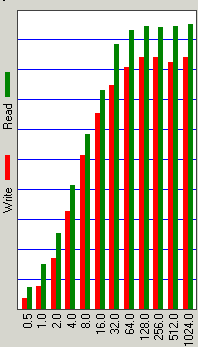
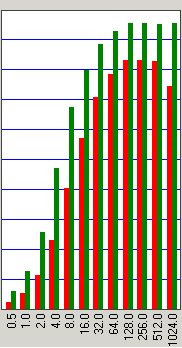
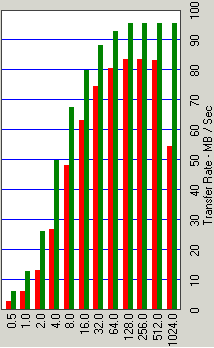


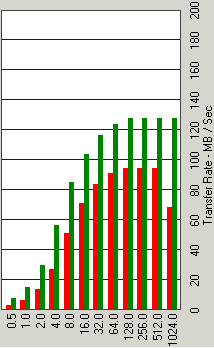

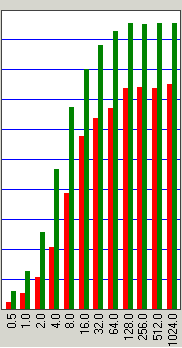
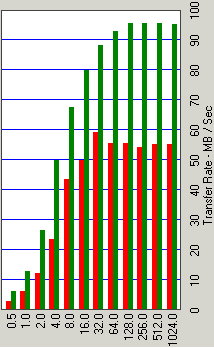


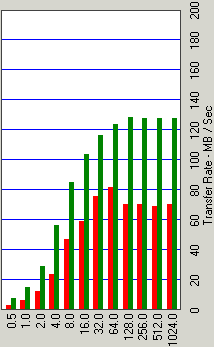
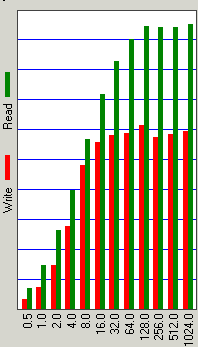
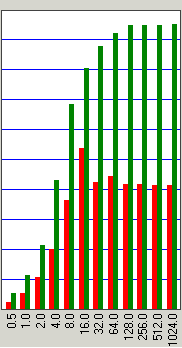
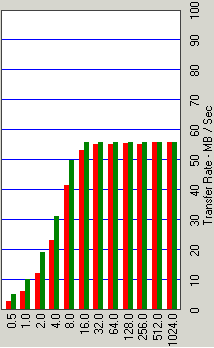
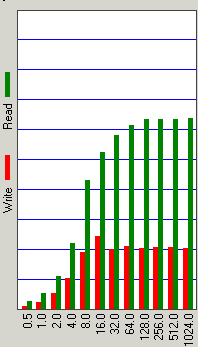
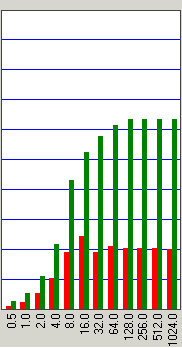
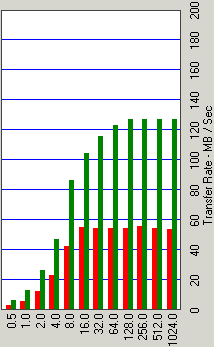
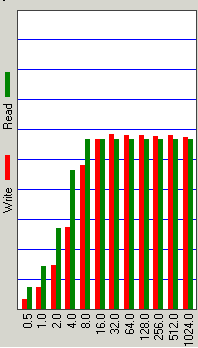

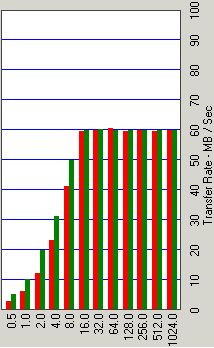

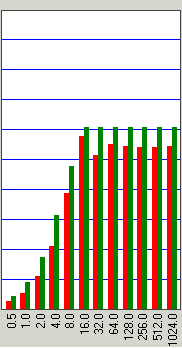

| « | » |
Another illustrative test of the "interior design" of the hard disks is the read/write speed on files of various sizes with various block sizes — from 512 bytes to 1 MB. For this purpose I traditionally use ATTO Disk Benchmark. The screenshots below display the results for the four sizes of a test file — 128 KB, 1 MB, 4 MB, and 32 MB. While the first and the second file sizes are, as a rule, surely cached in the disk buffer (caching read/write data for a 1 MB file is not that simple), there is simply no room to fit in the last file size. Caching the last but one file size depends not only on the buffer size, but also on the hard disk firmware (by the way, results of this test practically don't depend on the choice between FAT and NTFS).
| 128 KB test file: | ||
 |
 |
 |
|
180GXP (8 MB cache)
|
7K400 UltraATA
|
7K250 UATA (2 MB cache)
|
 |
 |
 |
|
7K400 SATA Quiet seek
|
7K400 Serial ATA
|
7K250 Serial ATA
|
|
|
||
 |
 |
 |
|
180GXP (8 MB cache)
|
7K400 UltraATA
|
7K250 UATA (2 MB cache)
|
 |
 |
 |
|
7K400 SATA Quiet seek
|
7K400 Serial ATA
|
7K250 Serial ATA
|
|
|
||
 |
 |
 |
|
180GXP (8 MB cache)
|
7K400 UltraATA
|
7K250 UATA (2 MB cache)
|
 |
 |
 |
|
7K400 SATA Quiet seek
|
7K400 Serial ATA
|
7K250 Serial ATA
|
|
|
||
 |
 |
 |
|
180GXP (8 MB cache)
|
7K400 UltraATA
|
7K250 UATA (2 MB cache)
|
 |
 |
 |
|
7K400 SATA Quiet seek
|
7K400 Serial ATA
|
7K250 Serial ATA
|
On the whole, IBM/Hitachi hard disks have not suffered any considerable changes in their firmware optimization for reading and writing files in various block sizes (judging from this test) for the three generations (from 180GXP to 7K400) — graphs for the hard disks of the three generations are very much alike. According to the test results we can draw a conclusion that the optimization of all Hitachi hard disks for the smallest blocks is satisfactory, though not the best among desktop competitors — the hard disks reach the full speed only at blocks starting from 16 KB. Moreover, while firmware optimization of the hard disks for reading files is generally good (anticipatory reading allows to read files of up to 4 MB practically at the speed of ATA interface), one cannot say that about caching writing data — even at relatively small 128 KB files the speed is obviously lower than the maximum possible speed (that is the interface data rate) and it's especially noticeable in SerialATA hard disks. When the file size increases to 1 MB, their writing speed drops (unlike the reading speed), and 4 Mb files (and less than 2 MB files for hard disks with 2 MB buffers) are written by the hard disks at the speed of their platters, not the interface data rate. That is caching data for writing stops being effective, though caching reading data still works well. One can note that the situation with caching data for writing (megabyte files) is a tad worse for 7K400 series hard disks than for their predecessors 7K250 and even 180GXP. It can be clearly seen even at 32 MB files, by the way. The 7K400 hard disk demonstrates practically no difference between the quiet and normal seek modes.
On the whole, taking into account the results of this and the previous tests, caching data for writing in 7K400 series hard disks is a tad worse compared to 7K250 series hard disks. While it still remains rather (in some cases – very) effective with small files and blocks, caching data for writing with megabyte files gets noticeably worse in modern desktop Hitachi hard disks, though caching data for reading remains very effective for file sizes of almost up to the cache buffer.
| « | » |